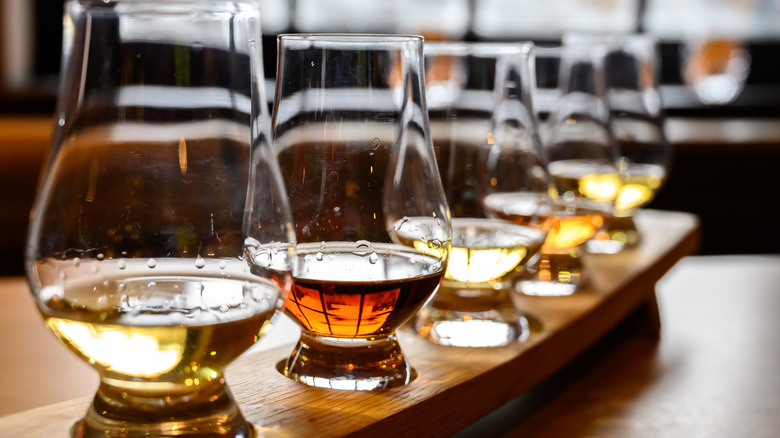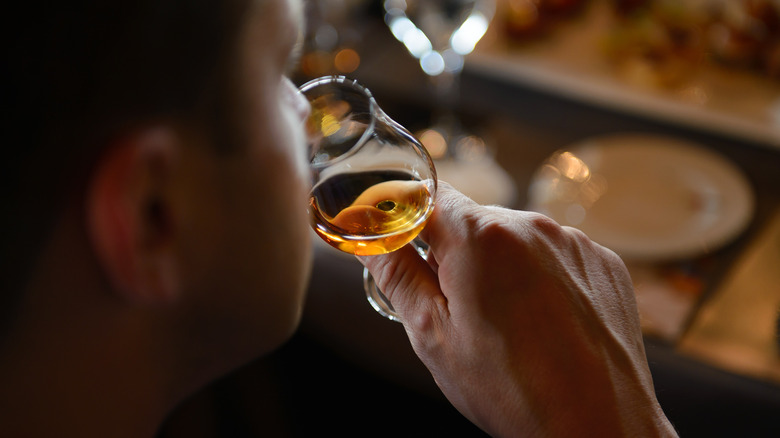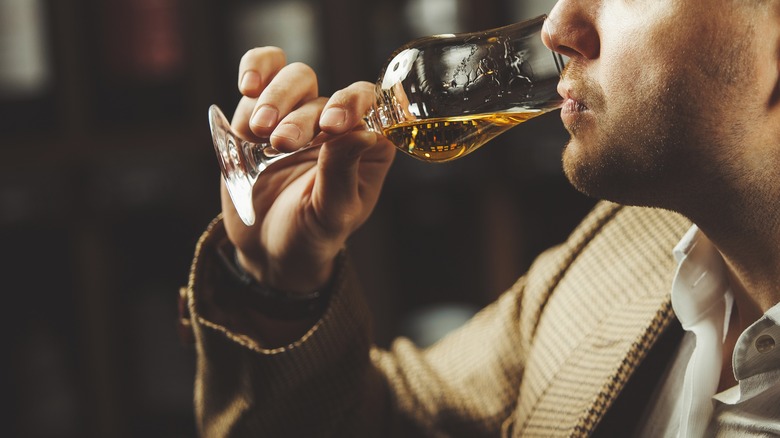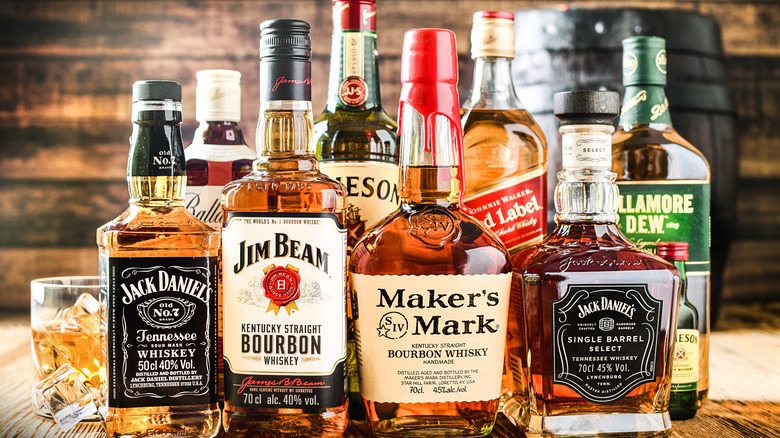How To Taste Whiskey Like A Pro
Whiskey tasting isn't always about taking minute sips and making notes about flavor profiles. Instead, it's a great way to learn about the nuances of the liquor, which comes in handy not just when drinking it neat or on the rocks but also when making whiskey cocktails or picking the perfect Scotch for a dinner party. Setting up a tasting at home is also quite simple, and there's no shortage of aspects to explore. For starters, ever wondered what the differences between whiskey and whisky (without an "e") are? You can also dive into the numerous food pairing options for a more gastro-focused whiskey-tasting party. However, it all begins with knowing how to taste whiskey the right way.
Chris Blatner, executive bourbon steward and creator of @urbanbourbonist on Instagram spoke exclusively to Foodie and dropped valuable advice for anyone looking to savor their whiskey. From prepping your palate to the finer points of nosing, tasting, and understanding the spirit's finish, Blatner covered all the major bases. Starting with the lowest-proof whiskey and moving up to higher-proof ones is generally the way to sequence the samples you plan on tasting, and it's never a good idea to drink it like a shot if you want to taste the subtleties. Blatner also warns against palate fatigue, saying tasting less kinds can help you taste more flavor in each. And before the tasting, even smelling it the right way can tell you a lot about a particular whiskey.
The nose
Nosing the whiskey is the first step in getting to know it since the aromas play a significant role in how it tastes. Putting your nose too close to the spirit right away, however, can have a numbing effect on the olfactory receptors. Instead, like the palate, the nose also has to be eased into the experience.
Blatner lays out the steps, explaining, "To properly nose a whiskey start with the glass at your chin and have your mouth open. Slowly raise the glass from your chin toward your nose and breathe in through your nose and mouth at the same time bringing the aromas into your nostrils. As you acclimate to the aromas you can bring the glass up closer to your nose and even put your nose into the glass. Continue to breathe in with your mouth open and you'll have the best experience."
Whiskey aromas can range from earthy, spicy, and woody to floral and even creamy. While the first few whiffs will feel alcohol-forward, the bouquet eventually opens up and you can distinguish more of the notes. Moving the glass from one nostril to another can also help pick up additional aromas. Adding ice during a nosing is not recommended, but a splash of water can actually help open up the aromas further.
The palate
The palate is the step when whiskey is actually tasted. Before tasting it, however, studying the spirit's clarity can give you a few hints about how it might play on the tastebuds. If it looks slightly cloudy or has a slight haziness, the whiskey may have relatively more fatty acids and esters, which give it a more viscous and oily mouthfeel. More transparency and clarity can be a sign that the whiskey is chill-filtered to remove such fatty acids and esters. Preferences about which tastes better differ.
Waking up your palate starts with a lower 90 to 100-proof whiskey and Executive Bourbon Steward Chris Blatner recommends a half-ounce pour, which is about one-third of a shot used in a standard drink. "This will get your tastebuds acclimated to common flavors and get them ready for a longer tasting session." Says Blatner. Taking smaller sips and holding them briefly in your mouth allows the whiskey to coat your palate, giving you a better sense of the flavors. Unlike with nosing, the lower temperature and additional dilution that ice provides may help with tasting some whiskeys.
Different styles of whiskey have specific tasting notes, so being aware of their presence can help you spot them. Peated Scotch has smoky and salty notes while unpeated Scotch veers towards malty, fruity, and floral flavors. Irish whiskey also has light floral notes. Bourbon, which is quite different from whiskey, has sweeter flavors reminiscent of caramel, vanilla, toffee, corn, and a hint of cinnamon.
The finish
The finish is essentially the aromas and flavors that linger after you've swallowed the whiskey. An important aspect of the finish is how long these traits can be felt, which can be a few minutes or a short finish, or sometimes stretch for hours, which is called a long finish. Broadly, a finish can feel warm, dry, clean, or even sharp, with certain deep flavors like spice, vanilla, oak, or salt remaining on the palate.
Because of the lingering effects of the finish, Executive Bourbon Steward Chris Blatner recommends cleansing your palate between tasting different whiskeys. He uses sparkling water for the job because the bubbles "scrub" the palate and help reset the taste buds. For more persistent finishes, plain oyster crackers or a similar lightly salted crisp, followed by sparkling water, can do the trick.
The whiskey expert also advises how to avoid palate fatigue, saying that beginners should start by tasting three to four whiskeys. Once it feels like you can't taste the differences between them, it's good to stop. And if you're still feeling adventurous at the end of your whiskey tasting, try ending things with a shot of pickle juice, which pairs surprisingly well with whiskey and can also act like a palate cleanser, albeit a not-so-subtle one.



